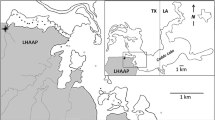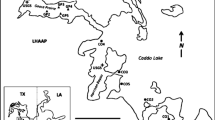Abstract
We evaluated the toxic-units model developed by Wildhaber and Schmitt (1996) as a predictor of indices of mean tolerance to pollution (i.e., Lenat, 1993; Hilsenhoff, 1987) and other benthic community indices from Great Lakes sediments containing complex mixtures of environmental contaminants (e.g., polychlorinated biphenyls – PCBs, polycyclic aromatic hydrocarbons – PAHs, pesticides, chlorinated dioxins, and metals). Sediment toxic units were defined as the ratio of the estimated pore-water concentration of a contaminant to its chronic toxicity as estimated by U.S. Environmental Protection Agency Ambient Water Quality Criteria (AWQC) or other applicable standard. The total hazard of a sediment to aquatic life was assessed by summing toxic units for all contaminants quantified. Among the benthic community metrics evaluated, total toxic units were most closely correlated with Lenat's (1993) and Hilsenhoff's (1987) indices of community tolerance (T L and T H , respectively); toxic units accounted for 42% T L and 53% T H of variability in community tolerance as measured by Ponar grabs. In contrast, taxonomic richness and Shannon-Wiener diversity were not correlated (P > 0.05) with toxic units. Substitution of order- or family-level identifications for lowest possible (mostly genus- or species-) level identifications in the calculation of T L and T H indices weakened the relationships with toxic units. Tolerance values based on order- and family-level identifications of benthos for artificial substrate samples were more strongly correlated with toxic units than tolerance values for benthos from Ponar grabs. The ability of the toxic-units model to predict the other two components (i.e., laboratory-measured sediment toxicity and benthic community composition) of the Sediment Quality Triad (SQT) may obviate the need for the SQT in some situations.
Similar content being viewed by others
References
American Society for Testing and Materials: 1988, ‘Standard Practice for Conducting Acute Toxicity Tests with Fishes, Macroinvertebrates, and Amphibians', in: Annual Book of ASTM Standards, American Society for Testing and Materials, Philadelphia, PA, pp. 1–20.
Boyle, T. P.: 1985, Validation and Predictability of Laboratory Methods for Assessing the Fate and Effects of Contaminants in Aquatic Ecosystems, ASTM, Philadelphia, PA. pp. 233.
Broderius, S. and Kahl, M.: 1985, ‘Acute Toxicity of Organic Chemical Mixtures to the Fathead Minnow', Aquat. Toxicol. 6, 307–322.
Burton, G. A., Jr.: 1993, Multi-Assay/Multi-Test Site Evaluation of Sediment Toxicity, Final Report. U.S. Environmental Protection Agency, Great Lakes National Program Office, Chicago, IL.
Canfield, T. J., La Point, T.W., Swift, M. C., Burton, G. A., Fairchild, J. A. and Kemble, N. E.: 1993, ‘Benthic Community Structure Evaluations', in: Ingersoll, C. G., Buckler, D. R., Crecelius, E. A. and La Point, T.W. (eds.), NFCRC-Battelle Final Report for the USEPA GLNPO Assessment and Remediation of Contaminated Sediments (ARCS) Project: Biological and Chemical Assessment of Contaminated Great Lakes Sediment, U.S. Environmental Protection Agency, Great Lakes National Program Office, Chicago, IL.
Canfield, T. J., Kemble, N. E., Brumbaugh, W. G., Dwyer, F. J., Ingersoll, C. G. and Fairchild, J. F.: 1994, ‘Use of Benthic Invertebrate Community Structure and the Sediment Quality Triad to Evaluate Metal-Contaminated Sediment in the Upper Clark Fork River, Montana', Environ. Toxicol. Chem. 13, 1999–2012.
Chapman, P. M., Dexter, R. N., and Long, E. R.: 1987, ‘Synoptic Measures of Sediment Contamination, Toxicity and Infaunal Community Composition (the Sediment Quality Triad) in San Francisco Bay', Mar. Ecol. Prog. Ser. 37, 75–96.
Chapman, P. M., Power, E. A., Dexter, R. N. and Andersen, H. B.: 1991, ‘Evaluation of Effects Associated with an Oil Platform, Using the Sediment Quality Triad', Environ. Toxicol. Chem. 10, 407–424.
Chapman, P. M.: 1992, ‘Sediment Quality Triad', in: U.S. Environmental Protection Agency (ed.), Sediment Classification Methods Compendium, U.S. Environmental Protection Agency, Office of Science and Technology, Washington, D.C.
de March, B. G. E.: 1988, ‘Acute Toxicity of Binary Mixtures of Five Cations (Cu2+, Cd2+, Zn2+, Mg2+ and K+) to the Freshwater Amphipod Gammarus lacustris (Sars): Alternative Descriptive Models', Can. J. Fish. Aquat. Sci. 45, 625–633.
Di Toro, D. M., Mahony, J. D., Hansen, D. J., Scott, K. J., Hicks, M. B., Mayr, S. M. and Redmond, M. S.: 1990, ‘Toxicity of Cadmium in Sediments: The Role of Acid Volatile Sulfide', Environ. Toxicol. Chem. 9, 1487–1502.
Di Toro, D. M., Zarba, C. S., Hansen, D. J., Berry, W. J., Swartz, R. C., Cowan, C. E., Pavlou, S. P., Allen, H. E., Thomas, N. A. and Paquin, P. R.: 1991, ‘Technical Basis for Establishing Sediment Quality Criteria for Non-Ionic Organic Chemicals by Using Equilibrium Partitioning', Environ. Toxicol. Chem. 10, 1541–1583.
Eadie, B. J.: 1984, ‘Cycling of Polynuclear Aromatic Hydrocarbons in the Great Lakes Ecosystem’ in: Nriagu, J. O. and Simmons, M. S. (eds.), Toxic Contaminants in the Great Lakes, Wiley, New York, pp. 213–238.
Giesy, J. P., Graney, R. L., Newsted, J. L., Rosiu, C. J., Benda, A., Kreis, Jr., R. G. and Horvath, F. J.: 1988, ‘Comparison of Three Sediment Bioassay Methods Using Detroit River Sediments', Environ. Toxicol. Chem. 7, 483–498.
Hilsenhoff, W. L.: 1977, Use of Arthropods to Evaluate Water Quality in Streams, Wisconsin Department of Natural Resources, Technical Bulletin No. 100.
Hilsenhoff, W. L.: 1982, Using a Biotic Index to Evaluate Water Quality in Streams, Wisconsin Department of Natural Resources, Technical Bulletin No. 132.
Hilsenhoff, W. L.: 1987, ‘An Improved Biotic Index of Organic Stream Pollution', Great Lakes Entomol. 20, 31–39.
Hilsenhoff, W. L.: 1988, ‘Seasonal Correction Factors for the Biotic Index', Great Lakes Entomol. 21, 9–13.
Ingersoll, C. G., Buckler, D. R., Crecelius, E. A. and La Point, T. W.: 1993, NFCRC-Battelle Final Report for the USEPA GLNPO Assessment and Remediation of Contaminated Sediments (ARCS) Project: Biological and Chemical Assessment of Contaminated Great Lakes Sediment, U.S. Environmental Protection Agency, Great Lakes National Program Office, Chicago, IL.
Konemann, H.: 1981, ‘Fish Toxicity Tests with Mixtures of More than Two Chemicals: a Proposal for a Quantitative Approach and Experimental Results', Toxicol. 19, 229–238.
Lemly, A. D., Finger, S. E. and Nelson, M. K.: 1993, ‘Sources and Impacts of Irrigation Drainwater Contaminants in AridWetlands', Environ. Toxicol. Chem. 12, 2265–2279.
Lenat, D. R.: 1983, ‘Chironomid Taxa Richness: Natural Variation and Use in Pollution Assessment', Freshwat. Invertebr. Biol. 2, 192–198.
Lenat, D. R.: 1993, ‘A Biotic Index for the Southeastern United States: Derivation and List of Tolerance Values, with Criteria for Assigning Water-Quality Ratings', J. N. Amer. Benthol. Soc. 12, 279–290.
Luoma, S. N. and Carter, J. L.: 1993, ‘Understanding the Toxicity of Contaminants in Sediments: Beyond the Bioassay-Based Paradigm', Environ. Toxicol. Chem. 12, 793–796.
Nelson, M. K., Coyle, J. J., King, L. B., Kemble, N. E., Crecelius, E. A. and Greer, I. E.: 1993, ‘Whole Sediment Toxicity Tests', in: C. G. Ingersoll, D. R. Buckler, E. A. Crecelius and T. W. La Point (eds.), NFCRC-Battelle Final Report for the USEPA GLNPO Assessment and Remediation of Contaminated Sediments (ARCS) Project: Biological and Chemical Assessment of Contaminated Great Lakes Sediment, U.S. Environmental Protection Agency, Great Lakes National Program Office, Chicago, IL.
Parrott, J. L. and Sprague, J. B.: 1993, ‘Patterns of Toxicity of Sublethal Mixtures of Metals and Organic Chemicals Determined by Microtox® and by DNA, RNA, and Protein Content of Fathead Minnows (Pimephales promelas)', Can. J. Fish. Aquat. Sci. 50, 2245–2253.
Plafkin, J. L., Barbour, M. T., Porter, K. D., Gross, S. K. and Hughes, R. M.: 1989, Rapid Bioassessment Protocols for Use in Streams and Rivers: Benthic Macroinvertebrates and Fish, U.S. Environmental Protection Agency, Assessment and Watershed Protection Division, Washington, DC.
Reynoldson, T. B., Bailey, R. C., Day, K. E. and Norris, R. H.: 1995, ‘Biological Guidance for Freshwater Sediment Based on Benthic Assessment of SedimenT (the BEAST) Using a Multivariate Approach for Predicting Biological State', Aust. J. Ecol. 20, 198–219.
Reynoldson, T. B. and Zarull, M. A.: 1989, ‘The Biological Assessment of Contaminated Sediments– the Detroit River Example', Hydrobiol. 188/189, 463–476.
Resh, V. H.: 1979, ‘Sampling Variability and Life History Features: Basic Considerations in the Design of Aquatic Insect Studies', J. Fish. Res. Bd. Can. 36, 290–311.
Schmitt, C. J., Wildhaber, M. L., Hunn, J. B., Nash, T., Tieger, M. N. and Steadman, B. L.: 1993, ‘Biomonitoring of Lead-Contaminated Missouri Streams with an Assay for Erythrocyte δ-Aminolevulinic Acid Dehydratase Activity in Fish Blood', Arch. Environ. Contam. Toxicol. 25, 464–475.
Schmitt, C. J.: (in press), ‘Environmental Contaminants', in: Mac, M. J., Opler, P. and Doran, P. (eds.), National Status and Trends Report, U.S. Geological Survey, Biological Resources Division. Reston, VA.
Sprague, J. B. and Ramsay, B. A.: 1965, ‘Lethal Levels of Mixed Copper-Zinc Solutions for Juvenile Salmon', J. Fish. Res. Bd. Can. 22, 425–432.
Suedel, B. C. and Rodgers, J. H., Jr.: 1994, ‘Development of Formulated Reference Sediments for Freshwater and Estuarine Sediment Testing', Environ. Toxicol. Chem. 13, 1163–1175.
Suter, G., Barnthouse, L., Efroymson, R., Jaeger, H. and Beauchamp, J.: 1995, ‘Ecological Risk Assessment of the Fish Community of the Clinch River/Poplar Creek System', in: Abstract Book, Second SETAC World Congress, SETAC Press, Pensacola, FL.
Swartz, R. C., Schults, D.W., Ozretich, R. J., Lambertson, J. O., Cole, F. A., DeWitt, T. H., Redmond, M. S. and Ferraro, S. P.: 1995, ‘ΣPAH: A Model to Predict the Toxicity of Polynuclear Aromatic Hydrocarbon Mixtures in Field-collected Sediments', Environ. Toxicol. Chem. 14, 977–1987.
U.S. Environmental Protection Agency: 1984, Ambient Water Quality Criteria for Mercury, EPA 440/5-80-058, Washington, DC.
U.S. Environmental Protection Agency: 1985b, Ambient Water Quality Criteria for Ammonia, EPA 440/5-85-001, Washington, DC.
U.S. Environmental Protection Agency: 1986, Ambient Water Quality Criteria, EPA 440/5-86-001, Washington, DC.
U.S. Environmental Protection Agency: 1990, Assessment and Remediation of Contaminated Sediments (ARCS) Work Plan, U.S. Environmental Protection Agency, Great Lakes Program Office, Chicago, IL.
U.S. Environmental Protection Agency: 1993, Proposed Water Quality Guidance for the Great Lakes System, U.S. Environmental Protection Agency, Chicago, IL.
Warren, C. E.: 1971, Biology and Water Pollution Control, W. B. Saunders Company, Philadelphia, PA.
Washington, H. G.: 1984. ‘Diversity, Biotic, and Similarity Indices: A Review with Special Relevance to Aquatic Ecosystems', Water Res. 18(6), 53–694.
Waterhouse, J. C. D. and Farrell, M. P.: 1985, ‘Identifying Pollution Related Changes in Chironomid Communities as a Function of Taxonomic Rank', Can. J. Fish. Aquat. Sci. 42, 406–413.
Weast, R. C., Astle, M. J. and Beyer, W. H.: 1988, CRC Handbook of Chemistry and Physics, CRC Press, Inc., Boca Raton, FL.
Wildhaber, M. L. and Schmitt, C. J.: 1996, ‘Estimating Aquatic Toxicity as Determined Through Laboratory Tests of Great Lakes Sediments Containing Complex Mixtures of Environmental Contaminants', Environ. Monit. Assess., 41(3), 255–289.
Wildhaber, M. L. and Schmitt, C. J.: 1996, ‘Hazard Ranking of Contaminated Sediments Based on Chemical Analysis, Laboratory Toxicity Tests, andBenthic Community Composition: Prioritizing Sites for Remedial Action', J. Great Lakes Res. 22(3), 639–652.
Rights and permissions
About this article
Cite this article
Wildhaber, M.L., Schmitt, C.J. Indices of Benthic Community Tolerance in Contaminated Great Lakes Sediments: Relations with Sediment Contaminant Concentrations, Sediment Toxicity, and the Sediment Quality Triad. Environ Monit Assess 49, 23–49 (1998). https://doi.org/10.1023/A:1005716111754
Issue Date:
DOI: https://doi.org/10.1023/A:1005716111754




